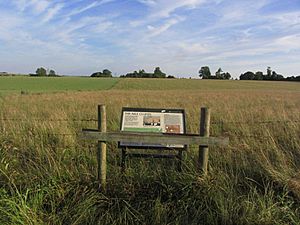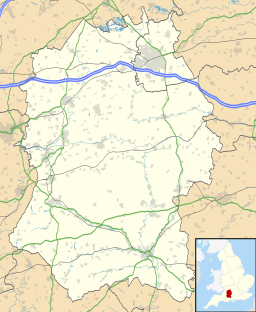Nile Clumps facts for kids
Quick facts for kids The Nile Clumps |
|
|---|---|

The Nile Clumps (which are on private land) seen from an information board on a public bridleway
|
|
| Location | Wiltshire, England, UK |
| Coordinates | 51°10′50″N 1°47′58″W / 51.1805°N 1.799526°W |
The Nile Clumps are groups of trees near Amesbury in Wiltshire, England. They are located on Salisbury Plain, a large open area. People believe these trees were planted long ago to remember a very important sea battle. This battle was called the Battle of the Nile.
Contents
The Nile Clumps: A Living Memorial
Remembering a Famous Battle
The Battle of the Nile happened between August 1 and 3, 1798. A British fleet, led by Admiral Horatio Nelson, fought against a French fleet. The battle took place in Aboukir Bay.
Admiral Nelson's British ships won a big victory. They defeated the French fleet, which was led by François-Paul Brueys d'Aigalliers. The French had thirteen large warships and four smaller ones. Nelson had fourteen large warships. Most of the French ships were destroyed or captured. No British ships were lost in the battle.
After Nelson died at the Battle of Trafalgar, a friend of his, Charles Douglas, 6th Marquess of Queensberry, wanted to honor him. He is thought to have planted groups of beech trees on his land near Amesbury. Each group of trees was meant to show where a British or French ship was during the Battle of the Nile.
It is believed there were once as many as twenty-six tree clumps. They were spread out over more than a kilometer. Today, about seventeen of these clumps still remain.
What They Look Like Today
Seventeen of the original tree clumps are still standing. They are now protected by special orders to keep them safe. However, beech trees usually live for about 200 years. This means many of the older trees are now dying.
Local volunteers are working hard to replant many of the clumps. Each replanted clump has about 200 new trees. These include beech, maple, and hawthorn trees. Some of the clumps that have been replanted are named after famous ships. These include Swiftsure, Defence, L'Orient, and Bellerophon.

The idea that these trees honor the battle comes from local stories. Also, the way the tree clumps are arranged looks very similar to a map of the battle. This map was drawn by an artist named Robert Dodd. The UK National Maritime Museum also thinks this link is "quite likely."
Most of the remaining clumps are on the north side of the A303 road. They are west of Amesbury. They are also inside the Stonehenge World Heritage Site. Some clumps used to be south of the road. Several of the remaining clumps are on land owned by the National Trust. This land is part of their Stonehenge Landscape property.
Other Tree Plantings
There is a plaque on the Nelson Memorial at Swarland. It mentions a line of trees shaped like the coastline of the Nile delta. Other trees there are placed where British and French ships were. These trees are west of the monument.
The Nile Clumps are sometimes mistakenly called the Trafalgar Clumps. However, they are different. There is a separate project called Trafalgar Woods. This project aims to plant 250,000 trees across the UK. It celebrates the 200th anniversary of the Battle of Trafalgar in 2005. This project will have 33 tree clumps. Each clump will represent a ship from that battle. The largest one will be Victory Wood in Kent, with 100,000 trees.


